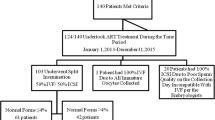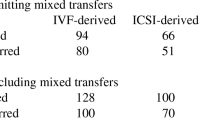Abstract
Purpose
To explore the effects of traditional vs. intracytoplasmic sperm injection (ICSI) insemination method on the outcome of high-quality blastocyst development in a split sibling oocyte cohort.
Methods
In this retrospective cohort study, we analyzed 62 ICSI/IVF split cycles. Sibling oocytes were randomly assigned to ICSI or IVF insemination. Two hundred thirty-four ICSI-only cycles and 152 IVF-only cycles were also analyzed for comparison. Blastocysts were graded by Gardner’s embryo grading and were considered a high-quality blastocyst if 3BB or better (Gardner 1999).
Results
In the ICSI/IVF split group, (1) ICSI oocytes had a higher fertilization rate per oocyte allocated (73% vs 62%, p < 0.001), (2) more high-quality day 2 embryos (69% vs 55%, p < 0.005), (3) ICSI oocytes had a lower blastulation rate per 2PN (46% vs 54%, p < 0.05), but a higher blastulation rate when calculated per oocyte allocated (40% vs 32%, p < 0.05). The ICSI-only group had a lower fertilization rate (65% vs 70%, p < 0.001) but more high-quality day 2 embryos in comparison to the IVF-only group (68% vs 64%, p < .05). The total high-quality blastulation rate was higher for the IVF-only group per 2PN (49% vs 43%, p < 0.05) and per oocyte retrieved (34% vs 28%, p < 0.05).
Conclusions
This distinctive IVF/ICSI sibling oocyte split design demonstrated a higher-quality blastulation rate in the IVF group compared to the ICSI group when calculated per 2PN, but not per oocyte allocated to each insemination procedure.
Similar content being viewed by others
References
Boulet SL, Mehta A, Kissin DM, Warner L, Kawwass JF, Jamieson DJ. Trends in use of and reproductive outcomes associated with intracytoplasmic sperm injection. JAMA. 2015;313(3):255–63.
Dieke AC, Mehta A, Kissin DM, Nangia AK, Warner L, Boulet SL. Intracytoplasmic sperm injection use in states with and without insurance coverage mandates for infertility treatment, United States, 2000-2015. Fertil Steril. 2018;109(4):691–7.
Belva F, Henriet S, Liebaers I, Van Steirteghem A, Celestin-Westreich S, Bonduelle M. Medical outcome of 8-year-old singleton ICSI children (born >or=32 weeks' gestation) and a spontaneously conceived comparison group. Hum Reprod. 2007;22(2):506–15.
Davies MJ, Moore VM, Willson KJ, Van Essen P, Priest K, Scott H, et al. Reproductive technologies and the risk of birth defects. N Engl J Med. 2012;366(19):1803–13.
Mazzilli R, Cimadomo D, Vaiarelli A, Capalbo A, Dovere L, Alviggi E, et al. Effect of the male factor on the clinical outcome of intracytoplasmic sperm injection combined with preimplantation aneuploidy testing: observational longitudinal cohort study of 1,219 consecutive cycles. Fertil Steril. 2017;108(6):961–72.e3.
Griffiths TA, Murdoch AP, Herbert M. Embryonic development in vitro is compromised by the ICSI procedure. Hum Reprod. 2000;15(7):1592–6.
Yoeli R, Orvieto R, Ashkenazi J, Shelef M, Ben-Rafael Z, Bar-Hava I. Comparison of embryo quality between intracytoplasmic sperm injection and in vitro fertilization in sibling oocytes. J Assist Reprod Genet. 2008;25(1):23–8.
Komsky-Elbaz A, Raziel A, Friedler S, Strassburger D, Kasterstein E, Komarovsky D, et al. Conventional IVF versus ICSI in sibling oocytes from couples with endometriosis and normozoospermic semen. J Assist Reprod Genet. 2013;30(2):251–7.
Khamsi F, Yavas Y, Roberge S, Wong JC, Lacanna IC, Endman M. Intracytoplasmic sperm injection increased fertilization and good-quality embryo formation in patients with non-male factor indications for in vitro fertilization: a prospective randomized study. Fertil Steril. 2001;75(2):342–7.
Gardner DKaS, W.B., editor. In vitro culture of human blastocysts. In: Jansen, R. and Mortimer, D., Eds., Towards Reproductive Certainty: Infertility and Genetics Beyond 1999: The Plenary Proceedings of the 11th World Congress on In Vitro Fertilization and Human Reproductive Genetics. 11th World Congress on In Vitro Fertilization and Human Reproductive Genetics. 1999, Parthenon Press.
Wang C, Feng G, Zhang B, Shu J, Zhou H, Gan X, et al. Influence of the insemination method on the outcomes of elective blastocyst culture. Clin Exp Reprod Med. 2017;44(2):85–9.
Rubino P, Viganò P, Luddi A, Piomboni P. The ICSI procedure from past to future: a systematic review of the more controversial aspects. Hum Reprod Update. 2016;22(2):194–227.
Van Landuyt L, De Vos A, Joris H, Verheyen G, Devroey P, Van Steirteghem A. Blastocyst formation in in vitro fertilization versus intracytoplasmic sperm injection cycles: influence of the fertilization procedure. Fertil Steril. 2005;83(5):1397–403.
Motoishi M, Goto K, Tomita K, Ookutsu S, Nakanishi Y. Examination of the safety of intracytoplasmic injection procedures by using bovine zygotes. Hum Reprod. 1996;11(3):618–20.
Hewitson L, Dominko T, Takahashi D, Martinovich C, Ramalho-Santos J, Sutovsky P, et al. Unique checkpoints during the first cell cycle of fertilization after intracytoplasmic sperm injection in rhesus monkeys. Nat Med. 1999;5(4):431–3.
Van Der Westerlaken LA, Helmerhorst FM, Hermans J, Naaktgeboren N. Intracytoplasmic sperm injection: position of the polar body affects pregnancy rate. Hum Reprod. 1999;14(10):2565–9.
Blake M, Garrisi J, Tomkin G, Cohen J. Sperm deposition site during ICSI affects fertilization and development. Fertil Steril. 2000;73(1):31–7.
Miller JE, Smith TT. The effect of intracytoplasmic sperm injection and semen parameters on blastocyst development in vitro. Hum Reprod. 2001;16(5):918–24.
Staessen C, Camus M, Clasen K, De Vos A, Van Steirteghem A. Conventional in-vitro fertilization versus intracytoplasmic sperm injection in sibling oocytes from couples with tubal infertility and normozoospermic semen. Hum Reprod. 1999;14(10):2474–9.
Verheyen G, Tournaye H, Staessen C, De Vos A, Vandervorst M, Van Steirteghem A. Controlled comparison of conventional in-vitro fertilization and intracytoplasmic sperm injection in patients with asthenozoospermia. Hum Reprod. 1999;14(9):2313–9.
Nagy ZP, Janssenswillen C, Janssens R, De Vos A, Staessen C, Van de Velde H, et al. Timing of oocyte activation, pronucleus formation and cleavage in humans after intracytoplasmic sperm injection (ICSI) with testicular spermatozoa and after ICSI or in-vitro fertilization on sibling oocytes with ejaculated spermatozoa. Hum Reprod. 1998;13(6):1606–12.
Funding
This research did not receive any specific grant from funding agencies in the public, commercial, or not-for-profit sectors.
Author information
Authors and Affiliations
Corresponding author
Ethics declarations
Declarations of interest
None
Additional information
Publisher’s note
Springer Nature remains neutral with regard to jurisdictional claims in published maps and institutional affiliations.
Rights and permissions
About this article
Cite this article
Sauerbrun-Cutler, MT., Huber, W.J., Has, P. et al. Is intracytoplasmic sperm (ICSI) better than traditional in vitro fertilization (IVF): confirmation of higher blastocyst rates per oocyte using a split insemination design. J Assist Reprod Genet 37, 1661–1667 (2020). https://doi.org/10.1007/s10815-020-01819-1
Received:
Accepted:
Published:
Issue Date:
DOI: https://doi.org/10.1007/s10815-020-01819-1




